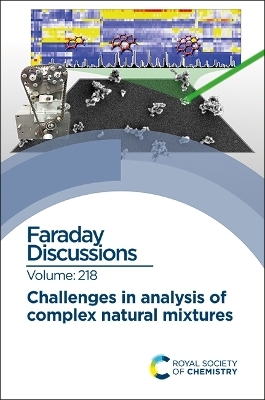
Challenges in Analysis of Complex Natural Mixtures
Faraday Discussion 218
Seiten
2019
Royal Society of Chemistry (Verlag)
978-1-78801-674-2 (ISBN)
Royal Society of Chemistry (Verlag)
978-1-78801-674-2 (ISBN)
In this volume, the topics covered include: Dealing with complexity: latest advances in mass spectrometry and chromatography, High-resolution techniques, from high-resolution mass spectrometry to NMR spectroscopy, Data mining and visualisation and Future challenges and new approaches
Structure determination of molecules contained within unresolved complex mixtures represents an unsolved question that continues to challenge physical and analytical chemistry. Most naturally occurring systems can be characterised as complex mixtures. These can be broadly divided according to the molecular sizes of their constituents, into mixtures of small or large molecules; the focus of this volume is on the former. While large molecules such as biomacromolecules, industrial polymers, or solid matrices are outside of the scope of this volume, the processes that are used in analysing the data originating from these studies may be of interest.
Small molecule mixtures include environmental matrices (such as soil, dissolved organic matter, organic molecules contained in atmospheric aerosol particles, or crude oil), biofluids, and man-made mixtures of small molecules such as food, beverages or plant extracts. These systems are generally classed as “complex mixtures” or “unresolved complex mixtures (UCM)”, emphasising our current inability to separate their individual components. The techniques best positioned to tackle such mixtures experimentally include mass spectrometry, chromatography, NMR spectroscopy, or new alternative techniques, including combinations of the above methods. For the most part, people who work on the analysis of complex mixtures are driving the progress in exploiting new methodologies and their creative combinations.
In this volume, the topics covered include:
Dealing with complexity: latest advances in mass spectrometry and chromatography
High-resolution techniques, from high-resolution mass spectrometry to NMR spectroscopy
Data mining and visualisation
Future challenges and new approaches
Structure determination of molecules contained within unresolved complex mixtures represents an unsolved question that continues to challenge physical and analytical chemistry. Most naturally occurring systems can be characterised as complex mixtures. These can be broadly divided according to the molecular sizes of their constituents, into mixtures of small or large molecules; the focus of this volume is on the former. While large molecules such as biomacromolecules, industrial polymers, or solid matrices are outside of the scope of this volume, the processes that are used in analysing the data originating from these studies may be of interest.
Small molecule mixtures include environmental matrices (such as soil, dissolved organic matter, organic molecules contained in atmospheric aerosol particles, or crude oil), biofluids, and man-made mixtures of small molecules such as food, beverages or plant extracts. These systems are generally classed as “complex mixtures” or “unresolved complex mixtures (UCM)”, emphasising our current inability to separate their individual components. The techniques best positioned to tackle such mixtures experimentally include mass spectrometry, chromatography, NMR spectroscopy, or new alternative techniques, including combinations of the above methods. For the most part, people who work on the analysis of complex mixtures are driving the progress in exploiting new methodologies and their creative combinations.
In this volume, the topics covered include:
Dealing with complexity: latest advances in mass spectrometry and chromatography
High-resolution techniques, from high-resolution mass spectrometry to NMR spectroscopy
Data mining and visualisation
Future challenges and new approaches
Faraday Discussions documents a long-established series of Faraday Discussion meetings which provide a unique international forum for the exchange of views and newly acquired results in developing areas of physical chemistry, biophysical chemistry and chemical physics. The papers presented are published in the Faraday Discussion volume together with a record of the discussion contributions made at the meeting. Faraday Discussions therefore provide an important record of current international knowledge and views in the field concerned. The latest (2017) impact factor of Faraday Discussions is 3.427.
Dealing with Complexity;
High-resolution Techniques;
Data Mining and Visualisation;
Future Challenges and New Approaches
| Erscheinungsdatum | 02.09.2019 |
|---|---|
| Reihe/Serie | Faraday Discussions ; Volume 218 |
| Mitarbeit |
Sonstige Mitarbeit: Royal Society of Chemistry |
| Verlagsort | Cambridge |
| Sprache | englisch |
| Maße | 156 x 234 mm |
| Gewicht | 930 g |
| Themenwelt | Naturwissenschaften ► Chemie ► Analytische Chemie |
| Naturwissenschaften ► Chemie ► Physikalische Chemie | |
| ISBN-10 | 1-78801-674-2 / 1788016742 |
| ISBN-13 | 978-1-78801-674-2 / 9781788016742 |
| Zustand | Neuware |
| Haben Sie eine Frage zum Produkt? |
Mehr entdecken
aus dem Bereich
aus dem Bereich


